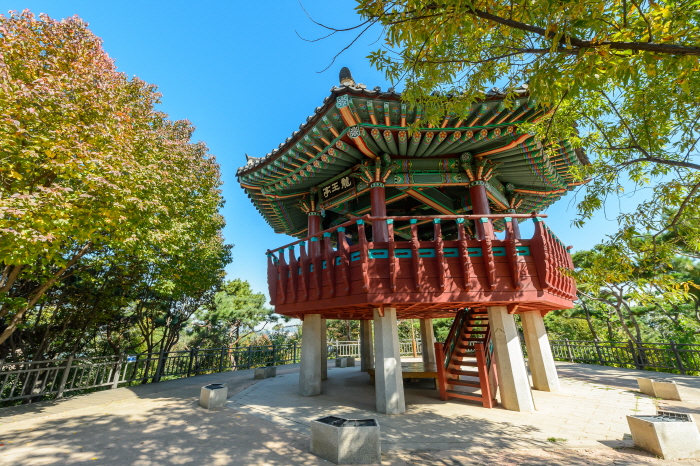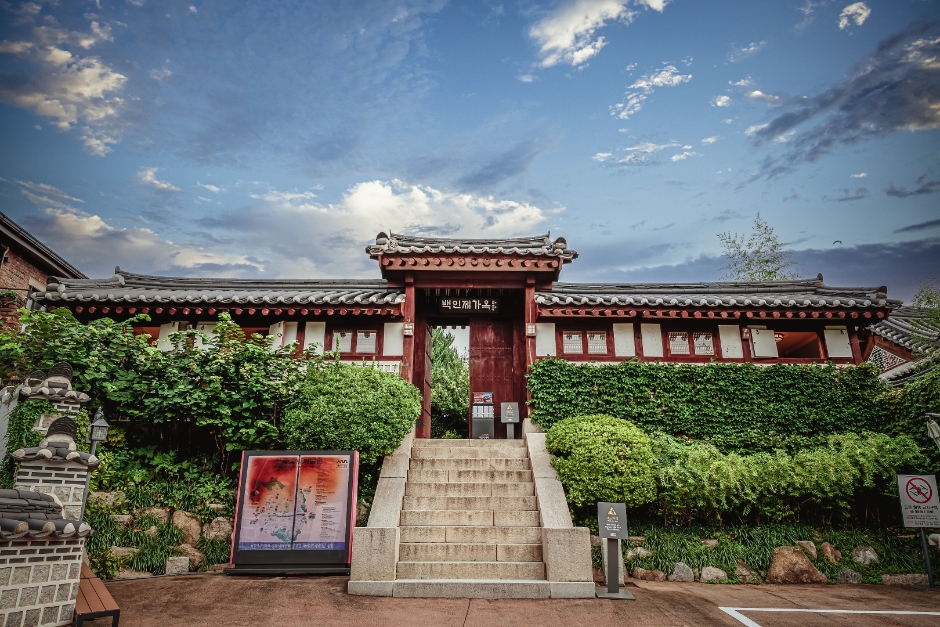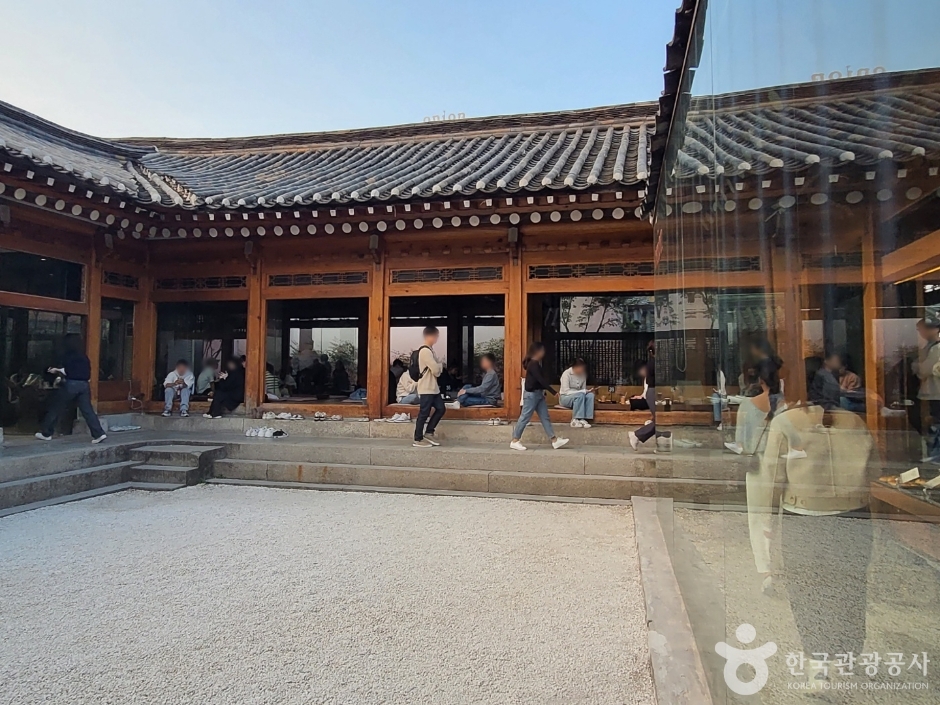Parque Municipal del Monte Yongwangsan (용왕산근린공원)
5.2Km 2021-12-28
Yongwangjeong-gil 41, Yangcheon-gu, Seúl.
Este monte también es conocido bajo el nombre de Eomjisan. Su nombre literamente significa "montaña del rey dragón".
Residencia Baek In-je (백인제가옥)
5.2Km 2025-04-18
Bukchon-ro 7-gil 16, Jongno-gu, Seúl
La Residencia Baek In-je está situada en Gahoe-dong. Este edificio conserva el estilo moderno de hanok diseñado durante la colonización japonesa. En un terreno amplia de 2.460 ㎡, la vivienda cuenta con habitaciones y jardines alrededor del salón principal. También hay un pequeño espacio separado para el descanso. La casa mantiene la belleza tradicional del propio hanok con remodelaciones. Así, es una de las representaciones arquitectónicas más conocidas del barrio de Bukchon, junto con la Residencia Yoon Bo-seon.
Diversas características destacan la casa construida en pino negral, presentado por primera vez en Seúl durante la Exposición de Gyeongseong en 1907. Por ejemplo, la Residencia Baek In-je está compuesta por un pasillo que une el salón y las habitaciones, lo que es peculiar en comparación con el hanok clásico. Por otro lado, el pasillo al estilo japonés, la habitación con esteras, el empleo de ladrillos rojos y ventanas de cristal reflejan el paisaje de la época. Asimismo, el salón suele ser de un piso, pero está dividido en dos plantas en esta construcción. Siendo un patrimonio cultural, este lugar agrupa toda la hermosura de hanok, permitiendo contemplar del jardín al salón, del patio al interior de la casa y del trasero del inmueble separado.
Museo Whanki (환기미술관)
5.2Km 2021-05-21
Jahamun-ro 40-gil 63, Jongno-gu, Seúl
La Fundación Whanji inauguró el Museo Whanki en 1992 en honor al pintor Kim Whanki (1931-1974). El museo posee alrededor de 300 piezas de Kim Whanki, así como realizar diversas exhibiciones especiales sobre el arte contemporáneo y otros eventos, además de exposiciones permanentes de las obras de Kim Whanki. Con dichas actividades, el Museo Whanki se esfuerza por recordar el valor del pintor Kim y sus influencias, y desarrollar más el arte coreano.
Residencia Real Unhyeongung en Seúl (서울 운현궁)
5.2Km 2021-11-29
Samil-daero 464, Jongno-gu, Seúl
Es un patrimonio cultural, designado Sitio Histórico, ubicado en Unni-dong, Jongno-gu. Antigüamente no era un palacio como lo es el de Gyeongbokgung, sino que se trataba de la residencia de los miembros de la Familia Real, pero con el paso del tiempo se lo ha considerado como un palacio. La denominación en coreano del palacio Gyeongbokgung sería “Gunggwol”. El término “Gung” hace referencia al espacio de residencia, mientras que la palabra “Gwol” se refiere al espacio político. Esto significa que en Gyeongbokgung se llevaba a cabo la vida cotidiana y política de la Corte Real; pero en Unhyeongung residía la Familia Real de Heungseon Daewongun, regente y padre del rey Gojong. Cabe señalar que hacia finales de la época Joseon, en esta residencia real se han originado la mayoría de los sucesos históricos, políticas revolucionarias, política de aislamiento, etc., todo lo cual resalta su simbolismo histórico.
La construcción para ampliar el palacio Unhyeongung comenzó a un mes de que Gojong asumiera el trono, a petición de la madre del Rey. En un principio, se encontraba localizado en el área intermedia entre los palacios Changdeokgung y Gyeongbokgung, pero a medida que se fue extendiendo, con una cantidad de edificaciones anexas, ha abarcado la zona actual que corresponde a la Universidad femenina de Duksung, el antiguo edificio de la emisora TBC, el Centro Cultural Japonés, la Escuela primaria Gyodong y el edificio de la compañía Samwhan.
El edificio principal de Unhyeongung es la sala Noandang, construida en septiembre de 1864. Entre otras construcciones famosas se destacan Norakdang, Irodang, y las cuatro puertas de acceso al palacio, aunque en la actualidad ha quedado una sola puerta. Norakdang, siendo la edificación central del palacio, fue el escenario de los grandes festivos familiares, y Noandang fue el despacho de Daewongun, la construcción más significativa en la vida de este hombre, ya que fue el lugar en donde pasó los momentos más importantes de su vida y donde falleció. Presenta un estilo arquitectónico tradicional coreano, con tejado, cuyos extremos estaban decorados elegantemente. Irodang, situado al lado Norakdang, tiene la forma de un cuadrado, y en su interior se encuentra un hermoso jardín. Este lugar ha recibido la atención y el cuidado solo durante el período de regencia de Heungseon Daewongun, ya que luego de su muerte, fue difícil el mantenimiento. La residencia ha tomado la apariencia actual a partir de noviembre de 1993, que es cuando el gobierno de Seúl tomó posesión del establecimiento, y por lo cual, ejecutó las obras de remodelación y restauración.
Aldea Tradicional Coreana Namsangol (남산골한옥마을)
5.2Km 2025-06-12
Toegye-ro 34-gil 28, Jung-gu, Seúl.
Si baja del metro de Seúl en la Estación de Chungmuro de las líneas 3 y 4 del metro, se hallará precisamente frente a la Aldea Tradicional Coreana Namsangol. Podrá considerar curioso que lugares como estos estén en medio de una concentración de rascacielos. Esta aldea tiene tres casas tradicionales restauradas, con un pabellón, un estanque y una cápsula del tiempo, que en su conjunto lo convierten en un destino turístico para apreciar las peculiaridades de las épocas antiguas de Corea.
Cuando pase por la entrada frontal, verá un vasto valle y el escenario Cheonugak junto al estanque. Cheonugak era un lugar donde se realizaban espectáculos de entretenimiento. Sobre uno de los lados observará cinco casas tradicionales. Estas casas fueron reconstruidas siguiendo el estilo de las casas tradicionales de la dinastía Joseon. Pertenecen a varias jerarquías sociales, desde la clase baja de los campesinos hasta el mismísimo rey. El mobiliario que concuerda con el propietario de la casa se halla dispuesto en su interior a fin de ayudarle a comprender el estilo de vida cotidiano de aquellos tiempos. Las impecables casas tradicionales y los desgastados utensilios de hogar son excelente material para fotografías. Si quisiera ver recuerdos del lugar, haga una parada en la exhibición de las artesanías tradicionales, pues allí venden pequeñas vasijas y recuerdos. Asimismo, podrá beber té tradicional y refrescos. En los patios hay juegos tradicionales que quizá desee intentar practicar, tales como neolttwigi (salto sobre el sube y baja), tuho (tiro de flecha) y yunnori (juego tradicional que consiste en arrojar cuatro varillas semicilíndricas a modo de dados). Otra cosa que no debería perderse es la ceremonia de boda tradicional.
Los fines de semana se muestran al público casamientos tradicionales en Bak Yeong-Hyo Ga (la casa de Bak Yeong Hyo). La ceremonia nupcial tradicional es un evento interesante tanto para los coreanos como para los extranjeros. Por ello, el lugar está siempre lleno de gente que se agolpa para mirar. Durante el invierno, de noviembre a febrero, no hay muchas ceremonias nupciales, las cuales se realizan con mayor frecuencia en primavera y otoño. Comúnmente, las ceremonias de boda tienen lugar entre el mediodía y las 13:00. Los turistas pueden tomarse fotografías junto a la pareja de marido y mujer luciendo sus trajes tradicionales de boda. Dentro de la aldea hay también una cápsula del tiempo para celebrar el Sexto Centenario de Seúl. Fue enterrada en 1994 y será abierta dentro de 400 años.
The Sool Gallery (전통주갤러리)
5.3Km 2025-05-28
Bukchon-ro 18, Jongno-gu, Seúl
Espacio del Hansik E:eum (한식문화공간 이음)
5.3Km 2025-05-28
Bukchon-ro 18, Jongno-gu, Seúl
Onion (Sucursal de Anguk) (어니언 안국)
5.3Km 2024-04-18
Gyedong-gil 5, Jongno-gu, Seúl
MyungBo Art Hall (명보아트홀)
5.3Km 2025-04-14
Mareunnae-ro 47, Jung-gu, Seúl
Espectáculo Cómico de Artes Marciales JUMP (코믹 마샬아츠 퍼포먼스 ‘점프’)
5.3Km 2025-07-17
Mareunnae-ro 47, Jung-gu, Seúl.
02-722-3995
Desde julio de 2003, en el que fue su primer debut en el escenario, JUMP ha venido recibiendo el aprecio de los espectadores, no solo nacionales sino también extranjeros. En 2005 y 2006 arrasó en el Festival Alternativo de Edimburgo y después inició una gira mundial acabando en el West End de Londres y en Broadway, Nueva York, demostrando así que esta comedia musical atrae a todo el mundo. El espectáculo incluye diferentes artes marciales orientales, como el taekwondo y el taekkyeon de Corea. La trama cuenta la historia de una familia de especialistas en artes marciales, quienes tienen que defender su casa de los ladrones.






 Español
Español
 한국어
한국어 English
English 日本語
日本語 中文(简体)
中文(简体) Deutsch
Deutsch Français
Français Русский
Русский